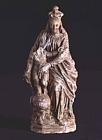July 5, 2005 (Tue) - September 25, 2005 (Sun)
Christianity was first introduced to Japan in August 1549 (Tenbun 18), when a group of Christians, led by Francis Xavier, arrived in Kagoshima on the island of Kyushu. It was accepted by commoners and tolerated by warlord, Oda Nobunaga.
For the Japanese, their faith in the Virgin Mary played an important role in accepting the new religion. The paintings of the Virgin Mary even created an impression on Buddhists, who felt a mysterious affinity with her. From 1587, following a military campaign in Kyushu, warlord Toyotomi Hideyoshi and his successor took steps to eliminate Christianity's influence. The prohibiting and persecution of Christianity continued until the early 1870's. While hiding from government persecution, the Christians' faith in the Virgin Mary continued to be strong. The missionaries had brought paintings and statues of the Virgin Mary to Japan, but because the journey was long and it was difficult to carry things over long distances, most of the items were quite small.
One example is the brass medallion depicting Saint Dominic receiving the rosary from the Virgin Mary. After being seized by the authorities, it was encased in wood and used as a tool against Christians. Known as fumi-e, the suspected Christians would be made to deny their faith and step on the medallion. These items reflect a dark and difficult time for Christian faith in Japan. Originally from Fujian province, China, a white porcelain statue of Kannon, but somewhat resembling the Virgin Mary, secretly allowed Christians to continue to worship in the midst of the government's persecution. While the items are small, the medallions and crosses feature images of the Virgin Mary and are a strong symbol of their faith.

